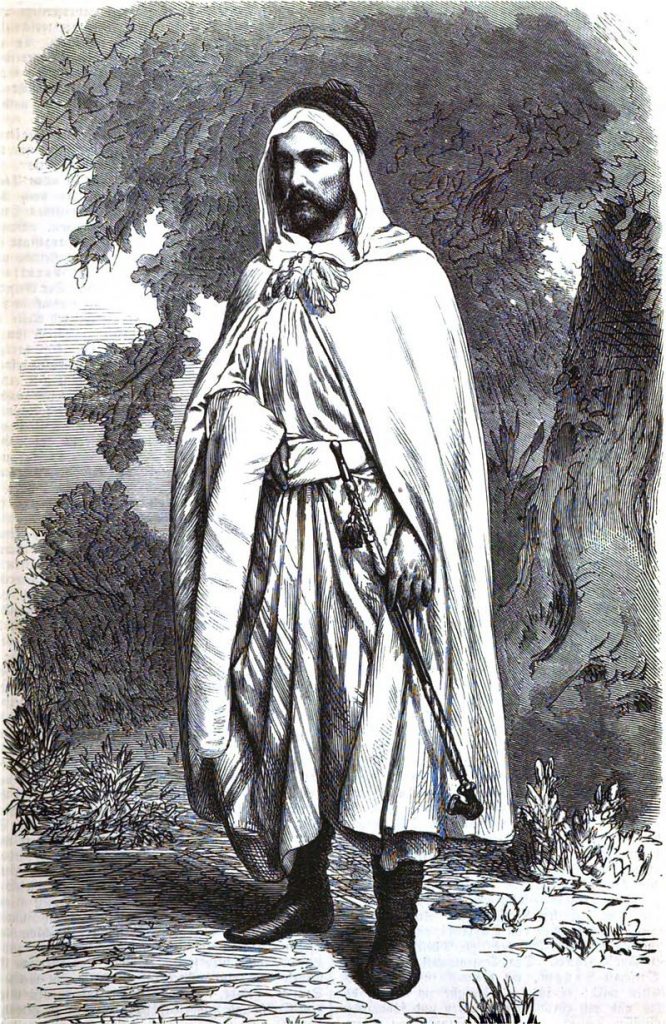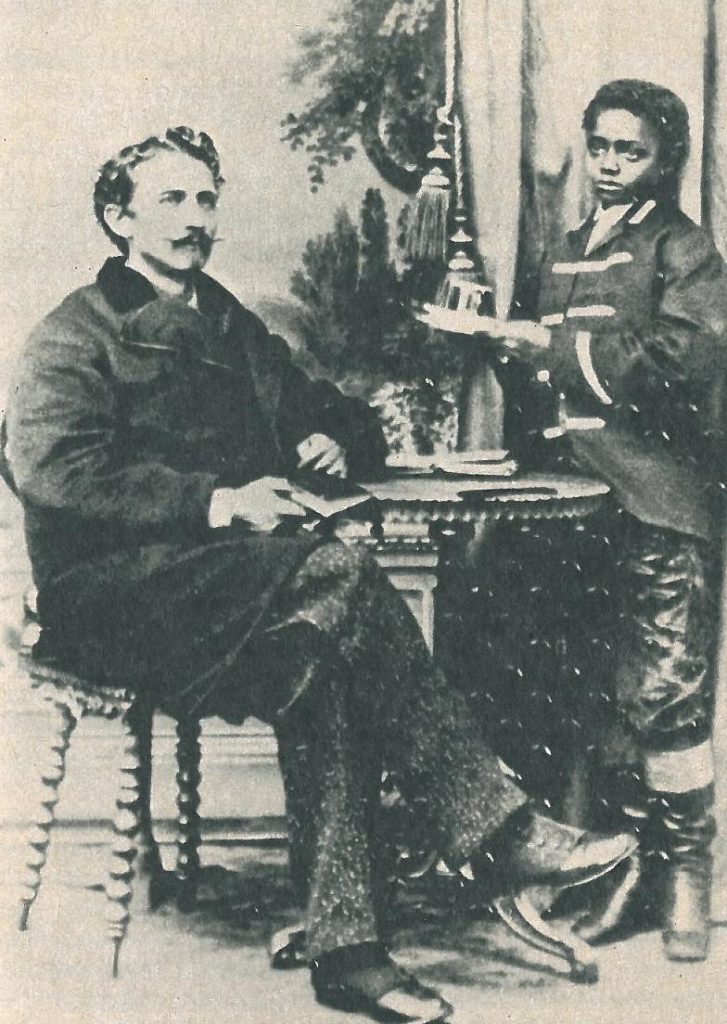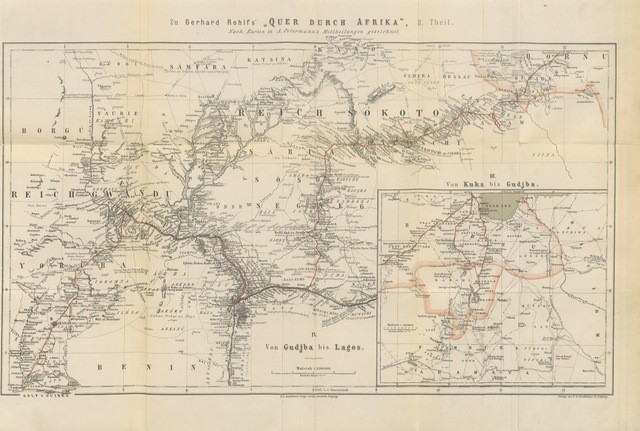How did Explorers shape German Colonial Thought?
Isabella Schwaderer
This Station on Instagram
Friedrich Gerhard Rohlfs (* 14 April 1831 in Vegesack near Bremen; † 2 June 1896 in Rüngsdorf near Bonn) was an Africa traveler and writer. After he took up residence in Weimar in the 1870s and built his first Villa Meinheim in today's Schopenhauerstraße, he built a second Villa Meinheimat 19 Belvederer Allee, for which the Grand Duke had given him the property. 1890 Rohlfs and his wife moved to Bad Godesberg, again to a Villa Meinheim, where he spent the rest of his life.
On the side of the building facing Belvederer Allee, clearly visible to people passing by, is a commemorative plaque for Gerhard Rohlfs with the following inscription:
Hier wohnte 1881-1890
Gerhard Rohlfs
1831-1896
Afrikaforscher
The plaque places Rohlfs in the ranks of Weimar's famous inhabitants and the grand duke's donation suggests his close ties to the ducal court. To what extent should this decoration ("Afrikaforscher=Africa Researcher") be subjected to further evaluation in the context of the German colonial history?
Gerhard Rohlfs - From Dropout and Adventurer to Imperial Observer
Rohlfs was the third son of a country doctor in Vegesack. After dropping out of school several times, he served as a soldier in five different armies, including the French Foreign Legion, which brought him to Algeria in 1856 along with the second Foreigners Regiment. After his early release from military duty, his traces are lost for a long time and the assumption that he was trained as a spy for French interests after his release is quite plausible.[1] The photo, based on which the shown copper engraving was made, was taken in Algiers in 1861 and shows him in local costume. Along with the remark that Rohlfs had at that time been familiar "with the customs and beliefs of this people"[2] the description led to the interpretation, that he knew the national language, which was convenient to him. His brother Hermann Rohlfs, who had visited the presumed missing Gerhard in Algiers, passed on his diaries to publishers and the cartographer August Petermann from Gotha, who published excerpts from this correspondence in his magazine Petermanns Geographische Mitteilungen (Petermann's Geographical Notes) and later supported him in the revision and publication of his travel notes. These made the traveler Rohlfs famous and promoted him to the ranks of recognized scientists.

At that time, geographical discoveries reached a broad reading public that liked to delve into the descriptions of distant, previously unknown countries and their characteristics, often supplemented by map material that was elaborately printed using newly developed processes. The explorers of this time, however, not only provided the publishing houses with descriptions of the geographical conditions, but also with clues that could become important for military exploration. Thus, explorers are deeply influenced by colonial thinking. Their audience, the German readers, began to participate in the production of knowledge about the big, wide world in the 18th century. That this by no means happened with altruistic and purely peaceful intentions is illustrated by Justin Stagl in his Geschichte der Neugier (History of Curiosity). He analyses the title page of Der reisende Deutsche (The Traveling German) from 1745, on which four allegorical figures symbolize the continents known at that time. An industrious secretary apparently notes down everything worth knowing and is surrounded by a seemingly disordered pile of utensils for observing, collecting and classifying: books, telescope and compass are part of the ensemble, but also pieces of armour lying around along with piled up cannonballs.[3]
Human Trophy and Showpiece of German Civilization Mission: Henry Noël
After a short visit in Germany Rohlfs returned to Africa and in 1865-1867, as one of the first Europeans, he crossed Africa from Tripoli through the Sahara over Lake Chad and along the Niger to today's Lagos at the Gulf of Guinea. In the Libyan oasis town of Murzuk, he treated a sick slave trader. Although Rohlfs had no medical knowledge worth mentioning, the man recovered and on December 25, 1865, he left an approximately seven-year-old boy to Rohlfs, who had presumably been abducted from Bagirmi, a sultanate in the region of present-day Chad, shortly before. Rohlfs took him, to whom he provisionally gave the name Noël (French: Christmas) - reminiscent of „Friday“ from Robinson Crusoe -, with him on his crossing of the Sahara, where the boy had apparently supported him and his other companion in serious illness - whereupon Rohlfs had him baptized in the name of Henry. An orphan, of whom only the first name Abd el Faradj is known, is imposed a new identity through the baptism in the name of Henry.[4] Taken violently from his family and cultural context at a very early age, Henry is not treated with dignity by the man who "saved" him or rather acquired him in an obscure trade. Although Rohlfs will bring him to Germany later, he will quickly and gladly hand over the responsibility for his upbringing to others.

In the picture shown here, Henry, in a circus-like costume with broad golden braids and oriental silk pants, is abused as a "perfect accessory" for the portrait of Rohlfs that was created in the photo studio. By this time, Rohlfs had become a respected scholar and successful lecture traveler. Henry completes the portrait's background of exotic plants like a "living proof" of the expertise of the portraited traveller, but his expression remains absent and sad. Although Rohlfs appeared as a decided opponent of the slave trade, with this picture he perpetuated the binary construct of master and servant,which is the prerequisite for the concept of white supremacy. Not only was Rohlfs one of the first (modern) Europeans to cross the entire Sahara in several directions, he also succeeded in cultivating this image and was celebrated for it. In Berlin he was received by King Wilhelm I. of Prussia and appointed honorary member of the Berlin Society of Geography. He received the gold medals of the Geographical Societies of Paris and London.

Henry had, in fact, crossed the Sahara twice, once abducted by slave traders from south to north and once with Rohlfs on his journey. He accompanied Rohlfs to Bremen and on the punitive expedition of Lord Robert Napier to Abyssinia. After the completion of this mission, Henry Noël was introduced to Wilhelm I. by Rohlfs in Bad Ems, his wife Augusta took care of the boy and tried to integrate him into the Prussian school system, but for various reasons this attempt did not succeed. In the end, Henry could not lead a self-determined life, neither in Germany nor later in Africa. Throughout his life Henry Noël fought for the recognition of his "savior" and "foster father", a role that Rohlfs never wanted to take on. Henry died on February 16, 1931 in a mental hospital in Ancona, Italy, where he had lived for 52 years. One can imagine how the abduction, enslavement and rejection of Rohlfs traumatized him. The dehumanization he experienced through slavery, renaming, and the rupture with home, family, and social environment at such an early age, as well as the constant objectification in pictures and words, are not directly, but indirectly documented by his psychological consequences and his stay in hospital. Why is Weimar displaying a not further commented commemorative plaque for Rohlfs, but not for Henry, formerly known as Abd el Farradj?
Rohlfs in Weimar, "Germany's Secret Colonial Capital"“[5]
In the meantime, Rohlfs earned his living with lecture tours and married the 19-year-old Auguste Leontine Behrens in 1870. On the recommendation of Princess Marie, a sister of Grand Duke Carl Alexander, who was "one of the strongest idealistic supporters of German Africa research and later of German colonial efforts in general"[6] , the couple temporarily settled in Weimar. During the times in which Rohlfs did not travel - partly for lectures, partly time and again to Africa - he and his wife, who played the piano very well, took part in the social life of Weimar with its numerous musical events; a special friendship connected them with Franz Liszt until his death in 1887.[7]
In order to keep the restless traveler, whose expenses often exceeded his income from travel grants and lecture fees, the Grand Duke Rohlfs eventually donated the property on Belvederer Allee worth 10,000 Marks in 1880, where the Rohlfs family moved into the second "Villa Meinheim".[8] It had all the features of a colonial "museum", filled with all kinds of 'souvenirs'. This is how the zoologist Konrad Guenther, Rohlf's nephew, describes it in a novel biography, which has made it into the bookshelves of Karl May:[9] gebracht hat:
"When the door opened, the visitor found himself facing a huge stuffed crocodile, a gift from Schweinfurth, hanging on the wall in the vestibule, surrounded by other African curiosities. [In the dining room,] the walls were covered with African furs, among them a lion skin and a black panther skin. The latter had been given to Rohlfs by the Emperor of Abyssinia and another one each to Kaiser Wilhelm and Bismarck. Between them hung pictures, one of Emperor Wilhelm I, of the Grand Duke of Weimar, a gift from the Duke, then various oil paintings, among these an excellent bust of Schweinfurth and one of Rohlfs himself, painted by Bohnstedt. On the table lay as cover a magnificent honor dress, given by the queen of Madagascar to the traveler."[10]
However, Rohlfs had not only brought gifts with him in the course of his travels; the reports about the conquest and plundering of the Abyssinian royal city of Magdala by the British in 1868, reports of which in different sources were quite contradictory, ended in a sellout and the destruction of irreplaceable cultural assets. How Rohlfs had come into possession of one of the royal crowns has never been entirely clear; in any case, the donation to King Wilhelm I and the transfer to the Museum für Völkerkunde (Museum of Ethnology) in Berlin caused such diplomatic entanglements with the British Crown that the founding director Adolf Bastian (1826-1905) wrote a letter to Rohlfs saying he was "glad that it is gone again".[11] Furthermore, he sent skulls from the graves he had opened in Dachel to the pathologist and anthropologist Rudolf Virchow[12] and a number of coins that became part of the collection of the University of Jena earned him an honorary doctorate.[13]
Travelling and mapping unknown lands was a first step towards military subjugation in the period of emerging colonialism. While the state in Germany only made tentative efforts to establish real colonies, colonial propaganda became increasingly public in the course of the 1870s. In 1873 the Afrikanische Gesellschaft in Deutschland (African Society in Germany) was founded, which expected to gain cultural capital from the geographical exploration of Africa. Rohlfs quotes its founder Bastian:
"The political status of a people determines the amount of obligations that are incumbent upon it in the solution of cultural tasks. Since Germany has regained its rightful seat in the Council of Nations, it must also be even more prominent in the cultivation of science than before, it is above all for Germany to take the lead in the management of geographical enterprises which are to gain new areas of knowledge, for such acquisitions are recorded in history under the name of the people who first boldly and resolutely broke the way for them."[14]
The acquisition of colonies was seen as advantageous for various reasons, especially because colonies would provide outlets for German industrial goods, a reservoir for German emigration, and would solve the "social question" - the workers would turn away from social democracy and instead become involved in a national project. Last but not least, however, Germany was supposed to have a "culture mission": the task of spreading its supposedly superior culture worldwide. Rohlfs had a decidedly positive attitude towards the German colonial aspirations and participated in the development of public opinion in his lectures and articles.[15]
Altogether Rohlfs could never establish himself professionally, despite the large public interest in his travels. His lack of education, his volatility and his overestimation of himself were also recognized by his contemporaries. The peak of his career as consul in Zanzibar in 1885, the island Bismarck wanted to secure for Germany, failed due to his personal and diplomatic mistakes and he was soon recalled. He no longer visited Africa and died in 1896 in Rüngsdorf near Bonn.
Cultivation of science and solutions to the „Culturaufgaben" - Who benefited from the Expeditions?
Rohlfs was well known for his travels, but especially due to the fascinating descriptions in his books these colonial fantasies were fuelled further. His commitment to the abolition of slavery coincided with the general opinion in Europe; however, in his personal dealings with African people, especially with Henry, he showed himself to be influenced by prevailing racist theories and always convinced of his and the European superiority over the inhabitants of the regions he explored. The plundering of cultural assets and the opening of graves for the "cultivation of science" seem to have caused just as little moral scruples with him as with the recipient of the human remains, Virchow, who in 1883 wrote the irritating as well as cryptic sentence into Rohlfs' guest book: "Is a white M** worth more than a white swallow? [...] But our teachers of descendancy are more eager to find out what kind of mollusks or arthropods we are descended from than to determine whether our ancestors were M**".[16]
Rohlfs' crossing of the Sahara, which had brought him much fame and honor, was an achievement that was accomplished there day after day by many locals; he could rely on the experiences of his leaders and, not least, the readiness of mind of the boy "given" to him. He collected samples and information for others and was therefore not so much a researcher of Africa as a "supplier" for other scientists without a research activity of his own, because he simply did not have the necessary education [17]. In any case, "Africa research" was not an academic subject, but a non-academic colonial category. It also suggests an extensive education, which Rohlfs never had. He had his books fundamentally edited by third parties, since otherwise they would not have been readable, which also cost him a large share of his royalties.[18] His honorary doctorate from the University of Jena was evidently a reward for handing over coins of dubious origin and no guarantee of higher education.

However, his persona of an "expert of Africa" that he had created in his early years wearing the clothing of the natives, in connection with the laconic descriptions of adventurous journeys, struck a nerve of generations, conveyed by Karl May. Although the novelist perhaps takes little from Rohlf's texts,[19] the impression remains that he took this phantastic staging of Rohlf as a model for one of his main characters and alter egosof Kara Ben Nemsi. May's popular novels have had a strong influence on the German feeling of cultural superiority.[20]
The Sahara is still frequently crossed today; particularly tragic is the omnipresent danger of death for numerous refugees, women, men and children, who try to reach the Maghreb states of Morocco, Algeria and Libya from sub-Saharan Africa. The causes of flight are diverse, but they are linked to the effects of the colonization of Africa prepared by explorers like Gerhard Rohlfs.
The villa of Gerhard Rohlfs in Weimar is a reminder of various things - of the journeys and "discoveries" of one man, but also to the colonial fantasies of an entire nation whose cultural claim to superiority was responsible for massacres in Africa - but also, ultimately, for war crimes and "industrial" mass killings of people who were not considered part of the "national community". Thus, a direct connection from Belvederer Allee 19 also leads to Buchenwald.
Sources
- Bolte, Günter (2019): Gerhard Rohlfs. Anmerkungen zu einem bewegten Leben. 1. Auflage. Rotenburg: Edition Falkenberg.
- Facius, Friedrich (1941): Carl Alexander von Weimar und die deutsche Kolonialpolitik 1850-1901. In: Koloniale Rundschau 32 (6), S. 339–353.
- Geulen, Christian (2009): Blutsbrüder. Über einige Affinitäten bei Carl Peters und Karl May, S. 309–339. Available online: https://www.karl-may-gesellschaft.de/kmg/seklit/JbKMG/2009/309.pdf.
- Gnettner, Horst (Hg.) (1996): Stammbuch des Bremer Afrikaforschers Gerhard Rohlfs. 60 Stammbuchblätter als Faksimiles. Museum Schloss Schönebeck. Bremen: Hauschild.
- Guenther, Konrad (1912): Gerhard Rohlfs Lebensbild eines Afrikaforschers. Anhang von Rudolph Said-Ruete. Freiburg: Friedrich Ernst Fehsenfeld.
- Lieblang, Helmut (1998): „…Ben Nemsi, Nachkomme der Deutschen…“ Karl May und Gerhard Rohlfs. Analog und disparat. In: Jahrbuch der Karl-May-Gesellschaft, S. 293–304. Available online: https://www.karl-may-gesellschaft.de/kmg/seklit/JbKMG/1998/293.htm.
- Merseburger, Peter (2004): Mythos Weimar. Zwischen Geist und Macht. 3. Aufl. München: Dt. Taschenbuch-Verl. (dtv, 30787).
- o.A. (Hg.): Verzeichnis der Bibliothek Karl Mays.
- Rohlfs, Gerhard (1873): Mein erster Aufenthalt in Marokko und Reise südlich vom Atlas durch die Oasen Draa und Tafilet. Bremen: Verlag von J. Kühtmann’s Buchhandlung.
- Rohlfs, Gerhard (1881): Reise von Tripolis nach der Oase Kufra. Ausgeführt im Auftrage der Afrikanischen Gesellschaft in Deutschland. Leipzig: F. A. Brockhaus.
- Stagl, Justin (2002): Eine Geschichte der Neugier. Wien: Böhlau. Available online: http://www.oapen.org/search?identifier=574816.
- Virchow, R. (1874): Köpfe aus den Oasen Dachel und Siuah. In: Verhandlungen der Berliner Gesellschaft für Anthropologie, S. 121–127.
Endnotes
[1] Bolte 2019: 30.
[2] Rohlfs 1873: 2.
[3] Stagl 2002: 202.
[4] In the following, the dehumanizing last name Noël is omitted.
[5] This is how Merseburger titles a chapter of his book Mythos Weimarin 2004, S. 213-241.
[6] Facius 1941: 351.
[7] Bolte 2019: 101.
[8] Bolte 2019: 131.
[9] o.A., Index of Karl May's Library: 11. Most of Rohlfs' books can also be found there.
[10] Guenther 1912: 265.
[11] Bolte 2019: 82 f.
[12] Virchow 1874.
[13] Bolte 2019: 102 f.
[14] Bastian according to Rohlfs, Rohlfs 1881.: 3.
[15] Bolte 2019: 161.
[16] Gnettner 1996.: o.S.
[17] Bolte 2019: 171.
[18] Bolte 2019. 172.
[19] Lieblang 1998 and Rohlfs 1873: 451.
[20] Geulen 2009.
